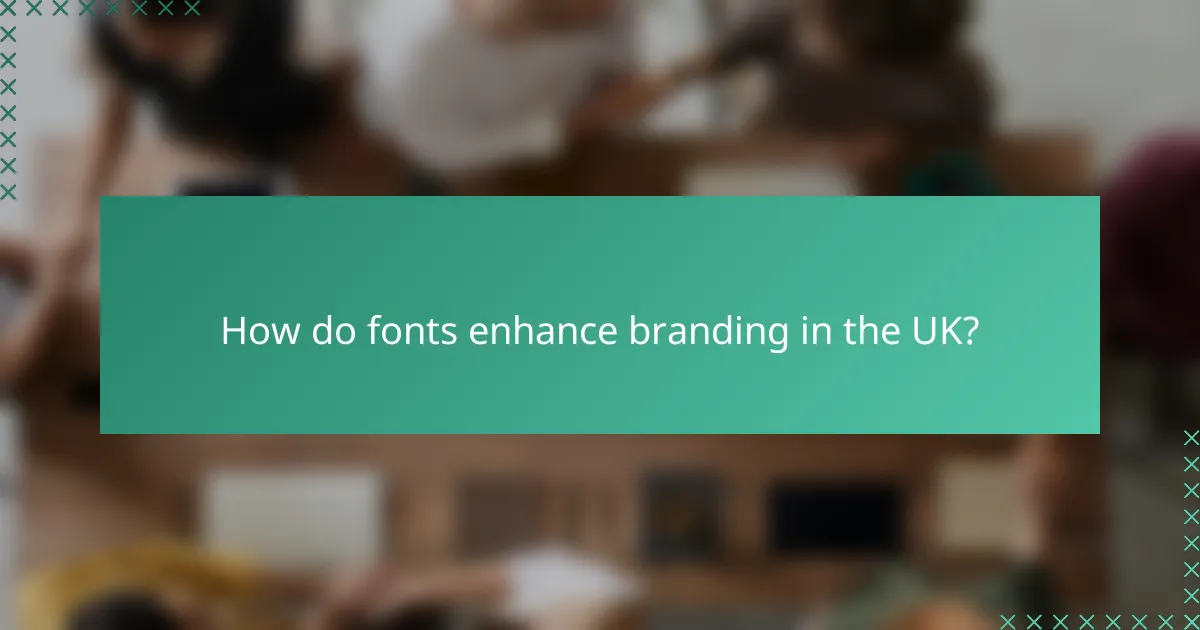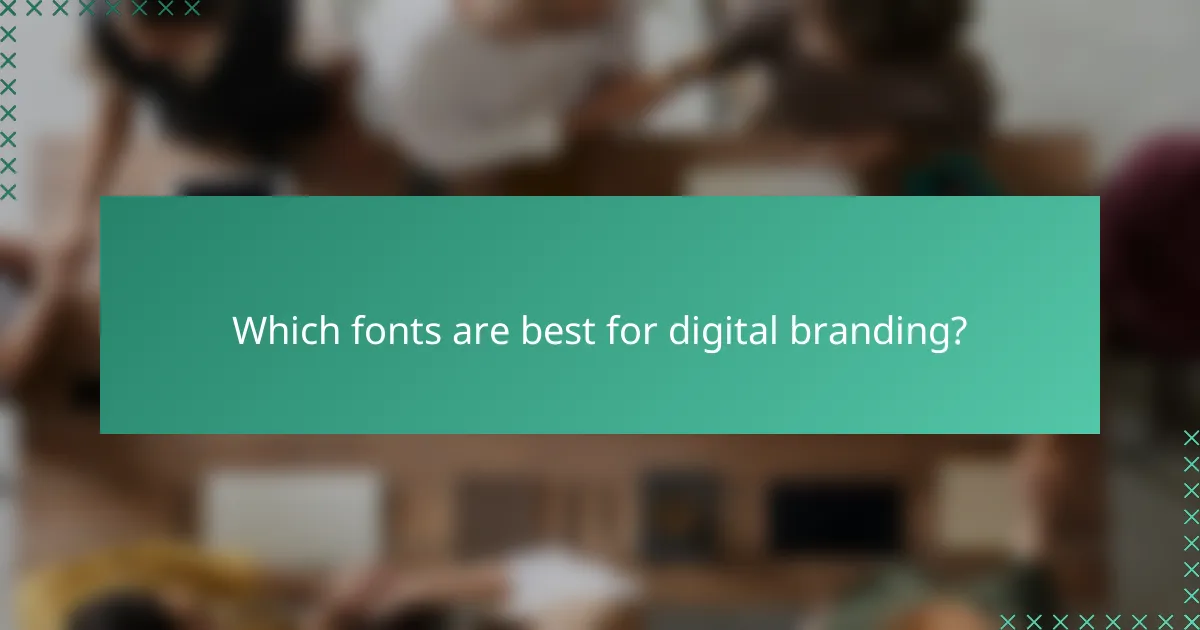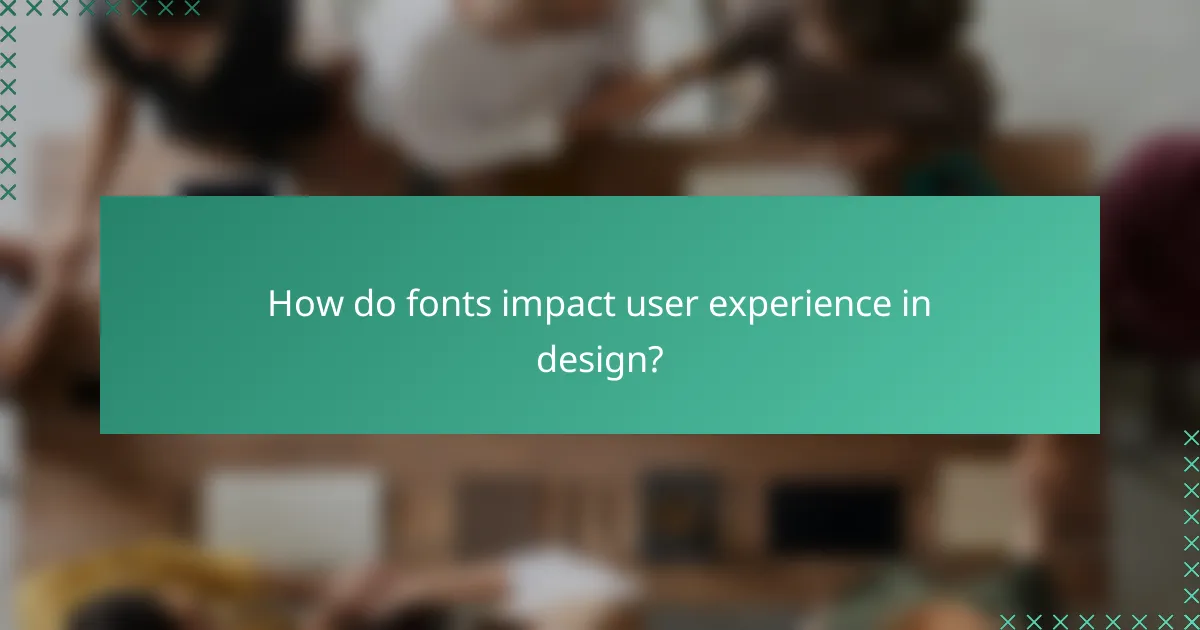Fonts are essential in shaping a brand’s visual identity and personality, influencing how consumers perceive and engage with a brand. Selecting the right typeface not only enhances readability but also conveys core values and emotions, making it a vital aspect of effective branding and design. Understanding your audience and aligning font choices with your brand’s message can significantly elevate creative projects.

How do fonts enhance branding in the UK?
Fonts play a crucial role in enhancing branding in the UK by shaping the visual identity and personality of a brand. The right typeface can convey values, evoke emotions, and create a lasting impression on consumers.
Visual identity creation
Fonts are a fundamental component of visual identity, helping to establish a brand’s unique look and feel. A well-chosen typeface can reflect the brand’s character, whether it’s modern, traditional, playful, or serious. For instance, a tech company might opt for sleek, sans-serif fonts to convey innovation, while a luxury brand may choose elegant serif fonts to suggest sophistication.
When selecting fonts, consider how they align with your brand’s mission and target audience. Consistency across all platforms, from websites to packaging, reinforces the visual identity and enhances brand recognition.
Emotional connection
Fonts can evoke specific emotions and associations, making them powerful tools for creating an emotional connection with consumers. For example, rounded fonts often feel friendly and approachable, while sharp, angular fonts can convey strength and reliability. Understanding the psychological impact of different typefaces can help brands connect more deeply with their audience.
To foster an emotional bond, choose fonts that resonate with your brand’s message and values. Testing different typefaces with your target demographic can provide insights into which fonts elicit the desired emotional responses.
Brand recognition
Consistent use of fonts across all branding materials enhances brand recognition, making it easier for consumers to identify and remember a brand. A distinctive font can become synonymous with a brand, similar to how Coca-Cola’s script font is instantly recognizable. This visual consistency helps to build trust and familiarity over time.
To improve brand recognition, establish clear guidelines for font usage, including size, color, and spacing. Regularly review your branding materials to ensure that the chosen fonts are applied consistently, reinforcing the brand’s identity in the minds of consumers.

Which fonts are best for digital branding?
The best fonts for digital branding are those that enhance readability and convey the brand’s personality. Choosing the right font can significantly impact user perception and engagement, making it essential to consider the brand’s message and target audience.
Sans-serif fonts
Sans-serif fonts are popular for digital branding due to their clean and modern appearance. They are often easier to read on screens, making them ideal for websites and mobile applications. Common examples include Arial, Helvetica, and Open Sans.
When selecting a sans-serif font, consider its weight and style to ensure it aligns with your brand’s voice. Lighter weights can convey a more approachable feel, while bolder styles may suggest strength and confidence.
Serif fonts
Serif fonts, characterized by their decorative strokes, can add a touch of elegance and tradition to digital branding. They are often used by brands that want to convey trust and authority, such as law firms or financial institutions. Examples include Times New Roman, Georgia, and Baskerville.
While serif fonts can enhance readability in print, their effectiveness on screens can vary. It’s advisable to choose a modern serif font designed for digital use to maintain clarity and legibility.
Display fonts
Display fonts are unique and attention-grabbing, making them suitable for headlines and branding elements. These fonts can range from playful to sophisticated, allowing brands to express their personality creatively. Examples include Lobster, Pacifico, and Bebas Neue.
When using display fonts, limit their use to specific areas like logos or promotional materials to avoid overwhelming the viewer. Ensure they complement the primary typeface used for body text to maintain a cohesive brand identity.

How to choose fonts for creative projects?
Choosing fonts for creative projects involves understanding your audience, aligning with your brand’s personality, and ensuring readability. The right font can enhance your design and effectively communicate your message.
Understand target audience
Identifying your target audience is crucial when selecting fonts. Different demographics respond to various styles; for instance, younger audiences may prefer modern, playful fonts, while older groups might favor classic, serif options.
Conducting surveys or analyzing existing data can help you determine the preferences of your audience. Consider factors such as age, profession, and cultural background to make informed font choices that resonate with them.
Consider brand personality
Your brand’s personality should guide your font selection. A tech company might opt for sleek, sans-serif fonts to convey innovation, while a luxury brand may choose elegant, serif fonts to evoke sophistication.
Develop a mood board that reflects your brand’s values and aesthetics. This visual reference can help you narrow down font choices that align with your overall branding strategy.
Evaluate readability
Readability is essential for effective communication. Ensure that your chosen fonts are legible across different sizes and mediums, from websites to printed materials. Aim for a minimum font size of 12 points for body text to maintain clarity.
Test your fonts in various contexts, such as on screens and in print, to assess their readability. Avoid overly decorative fonts for body text, as they can hinder comprehension. Instead, reserve them for headings or accents to maintain a balance between creativity and clarity.

What are the latest font trends in design?
The latest font trends in design focus on versatility, simplicity, and nostalgia. Designers are increasingly adopting styles that enhance readability while also allowing for creative expression.
Variable fonts
Variable fonts are a modern innovation that allows a single font file to contain multiple styles and weights. This flexibility enables designers to customize typography more easily, reducing load times and file sizes.
When using variable fonts, consider how different weights can convey various emotions or messages. For instance, a bolder weight may evoke strength, while a lighter weight can suggest elegance. Always ensure that the chosen styles align with your brand identity.
Geometric sans-serifs
Geometric sans-serifs are characterized by clean lines and simple shapes, making them highly legible and modern. These fonts often feature uniform stroke widths, which contribute to a minimalist aesthetic.
Popular examples include Futura and Avenir. When selecting a geometric sans-serif, think about how it complements your overall design and branding. These fonts work well in both digital and print formats, making them versatile choices for various applications.
Retro typography
Retro typography draws inspiration from past design eras, often featuring bold colors and unique letterforms. This trend taps into nostalgia, appealing to audiences by evoking familiarity and warmth.
When incorporating retro typography, balance it with modern elements to avoid overwhelming your design. Use it strategically for headlines or promotional materials to create a strong visual impact while maintaining brand coherence.

How do fonts impact user experience in design?
Fonts significantly influence user experience in design by affecting how easily content can be read and understood. The choice of typeface can enhance or hinder communication, impacting engagement and retention.
Readability and legibility
Readability refers to how easily text can be read, while legibility focuses on how distinguishable individual characters are. Choosing fonts with clear letterforms, appropriate spacing, and suitable sizes can enhance both readability and legibility. For instance, sans-serif fonts like Arial or Helvetica are often preferred for digital content due to their clean lines.
When designing, aim for a font size of at least 16 pixels for body text to ensure comfort during reading. Avoid overly decorative fonts for long passages, as they can strain the eyes and reduce comprehension.
Visual hierarchy
Visual hierarchy guides users through content by emphasizing important elements. Fonts play a crucial role in establishing this hierarchy through size, weight, and style variations. For example, using bold or larger fonts for headings helps users quickly identify key sections.
To create an effective visual hierarchy, consider using a maximum of three different font styles throughout your design. This keeps the layout clean and helps users navigate information without feeling overwhelmed.
Accessibility considerations
Accessibility in design ensures that all users, including those with visual impairments, can engage with content. Selecting fonts that are easy to read for individuals with dyslexia or low vision is essential. Fonts like Open Dyslexic or Arial can improve accessibility.
Additionally, ensure sufficient contrast between text and background colors to enhance readability. Following Web Content Accessibility Guidelines (WCAG), aim for a contrast ratio of at least 4.5:1 for normal text. This practice supports a wider audience and improves overall user experience.

What tools help in font selection?
Several tools can assist in selecting the right fonts for branding and design projects. These tools offer various features, including extensive font libraries, customization options, and user-friendly interfaces to streamline the selection process.
Adobe Fonts
Adobe Fonts provides a vast library of high-quality typefaces that can be easily integrated into Adobe Creative Cloud applications. Users can browse through thousands of fonts, filter by style, and even activate fonts directly for use in their projects.
One key advantage of Adobe Fonts is its seamless integration with design software, allowing for instant access and synchronization across devices. However, a subscription to Adobe Creative Cloud is required, which may not be ideal for those on a tight budget.
Google Fonts
Google Fonts is a free resource that offers a wide selection of open-source fonts suitable for web and print design. Users can explore various categories and styles, making it easy to find fonts that align with their branding needs.
One of the main benefits of Google Fonts is its accessibility; anyone can use the fonts without any licensing fees. Additionally, the platform provides easy embedding options for websites, ensuring that fonts render consistently across different browsers and devices.
